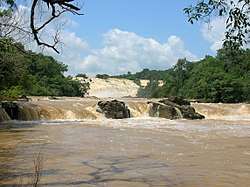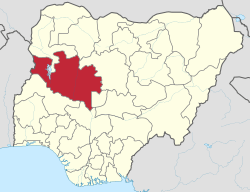Niger State
| Niger | |
|---|---|
| State | |
 Gurara Falls, a waterfall along the Gurara River in Niger State | |
| Nickname(s): The Power State | |
 Location of Niger State in Nigeria | |
| Coordinates: 10°00′N 6°00′E / 10.000°N 6.000°ECoordinates: 10°00′N 6°00′E / 10.000°N 6.000°E | |
| Country |
|
| Date created | 3 February 1976 |
| Capital | Minna |
| Government | |
| • Governor (List) | Abubakar Sani Bello (APC) |
| • Deputy Governor | Ahmed Muhammad Ketso |
| • Senators |
|
| Area | |
| • Total | 76,363 km2 (29,484 sq mi) |
| Area rank | 1st of 36 |
| Population (2006)[1] | |
| • Total | 3,954,772 |
| • Rank | 18th of 36 |
| • Density | 52/km2 (130/sq mi) |
| GDP (PPP) | |
| • Year | 2007 |
| • Total | $6.00 billion[2] |
| • Per capita | $1,480[2] |
| Time zone | UTC+01 (WAT) |
| ISO 3166 code | NG-NI |
| Website | nigerstate.gov.ng |
Niger or Niger State is a state in Central Nigeria and the largest state in the country. The state capital is Minna, and other major cities are Bida, Kontagora, and Suleja. It was formed in 1976 when the then North-Western State was bifurcated into Niger State and Sokoto State. It is home to Ibrahim Babangida[3] and Abdulsalami Alhaji Abubakar,[4] two of Nigeria's former military rulers. The Nupe, Gbagyi, Kamuku, Kambari, Dukawa, Hausa and Koro form the majority of numerous indigenous tribes of Niger State.
The state is named after the River Niger. Two of Nigeria's major hydroelectric power stations, the Kainji Dam and the Shiroro Dam, are located in Niger State, The famous Gurara Falls is in Niger State, and Gurara Local Government Area[5] is named after the Gurara River, on whose course the fall is situated. Also situated there is Kainji National Park, the largest National Park of Nigeria, which contains Kainji Lake, the Borgu Game Reserve and the Zugurma Game Reserve.[6]
Government
Like the majority of Nigerian states, it is governed by a Governor and a House of Assembly. Under the current administration of Abubakar Sani Bello.
Local Government Areas
Niger State consists of twenty-five (25) Local Government Areas. They are:
[ GARAGE ]
References
- ↑ "2006 PHC Priority Tables – NATIONAL POPULATION COMMISSION". population.gov.ng. Retrieved 2017-10-10.
- 1 2 "C-GIDD (Canback Global Income Distribution Database)". Canback Dangel. Retrieved 2008-08-20.
- ↑ Ibrahim Babangida
- ↑ Abdulsalami Abubakar
- ↑ Gurara
- ↑ "Kainji Lake National Park". United Nations Environment Programme: World Conservation Monitoring Centre. Archived from the original on 30 September 2007. Retrieved 21 October 2010.
External links
| Wikimedia Commons has media related to Niger State. |